

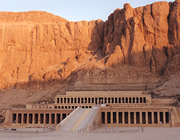
The tombs of nobles and workmen are some of the most interesting sites we've seen in Egypt, especially for the wall paintings of scenes of everyday life.
The Mortuary Temple of Hatshepsut is a favourite for its lovely symmetric architecture and location.
And a huge highlight was the fabulously restored tomb of Queen Nefertari.
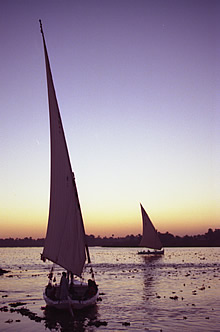
We had a guide with us on all our visits to the various sites on the West Bank of the Nile at Thebes, the old name for Luxor.
Groups don't usually visit the Tombs of the Nobles or the Workmen's Village and we had these sites blissfully to ourselves - much more atmospheric.
Photography is not allowed inside any of the tombs.
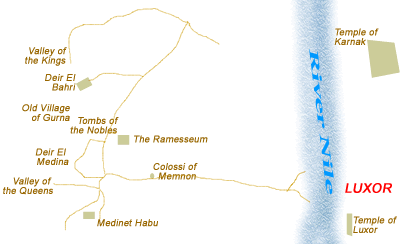
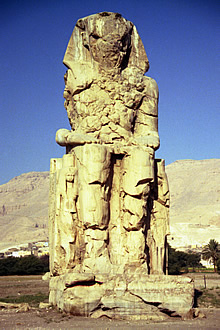
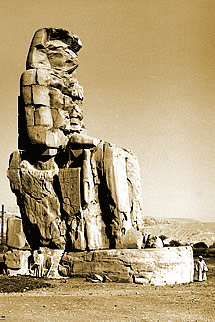
These two huge seated statues once flanked the tomb of Amenhotep III. They are almost 20m metres high and are carved with the figures of the pharaoh's mother, Mutemala, and wife Queen Tiy.
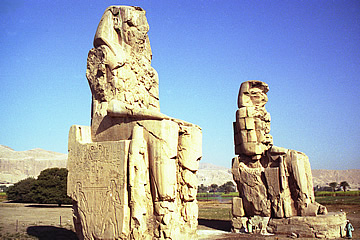
The statues have suffered greatly over the centuries, not least in the earthquake of 27 B.C. which destroyed the temple. The northern figure collapsed but the remains emitted a curious musical sound at sunrise.
The Greeks thereafter associated the statues with Memnon, the son of Aurora, the dawn goddess. Two hundred years later the Roman emperor Septimus Severus had the statues repaired and the "singing" stopped.1,2
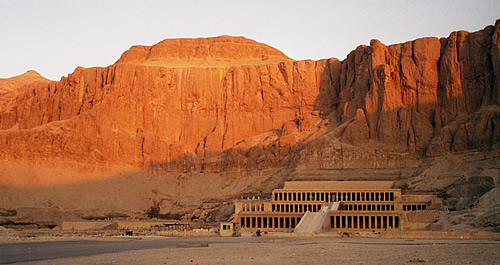
For me this is one of the most beautiful temples. I love the symmetric simplicity of the tiers of columns, though the bulky central ramp does spoil the effect a bit.
Hatshepsut was a remarkable woman; the daughter of Tuthmosis I she married her father's son and heir Tuthmosis II. They had no children so that when he died the son of one of his secondary wives became pharaoh: Tuthmosis III. As he was only a child at this time, Hatshepsut ruled in his place, eventually taking the step of declaring herself pharaoh.
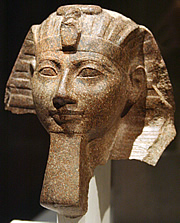
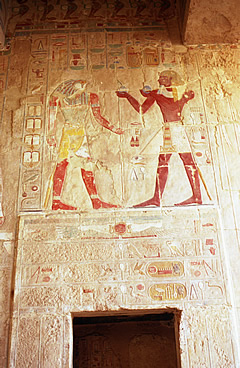
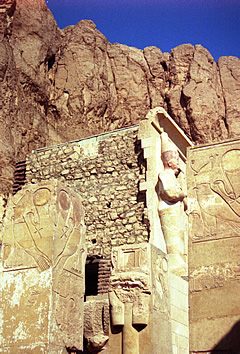
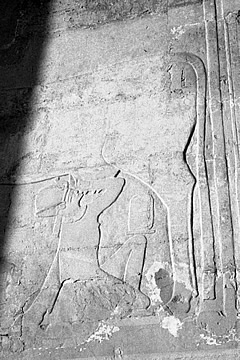
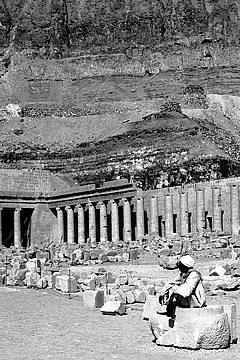
Hatshepsut was depicted as a man in many images as the pharaoh was, of course, traditionally male. She ruled for 20 years - even after Tuthmosis III reached manhood. It was only when she died that he took his place as ruler.
Tuthmosis III obliterated from the records as much of Hatshepsut as he could find, including temple images and instances of her name.
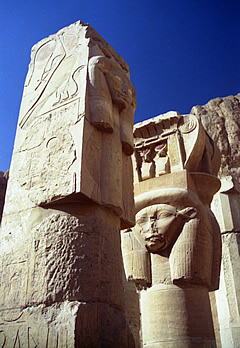
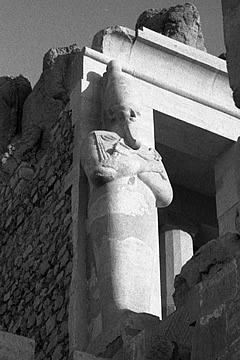
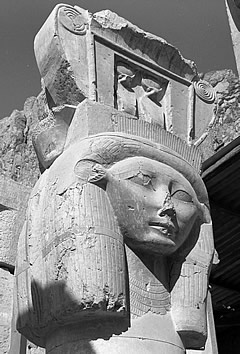
The temple is built in a series of terraces connected by ramps and sits in a beautiful location up against the cliff face and facing the Nile.
It is a magnificent sight as the rising sun gradually illuminates the facade revealing its beauty. Much of the temple is closed to visitors.
In the northern colonnade of the upper terrace are scenes of the divine birth of Hatshepsut - the child shown as a boy.
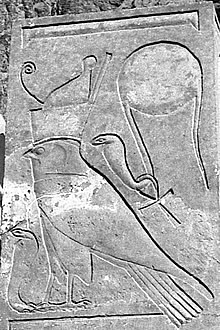
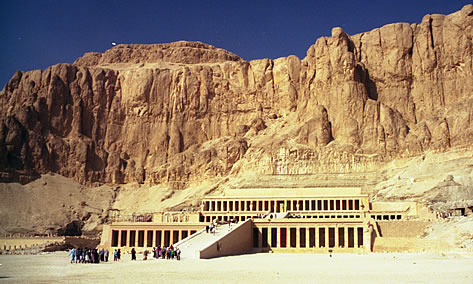
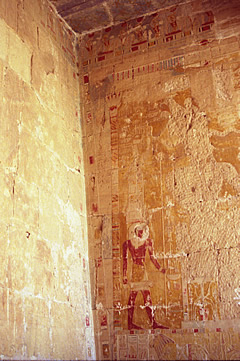
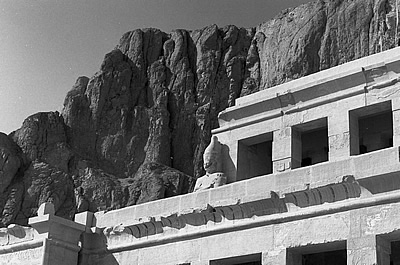
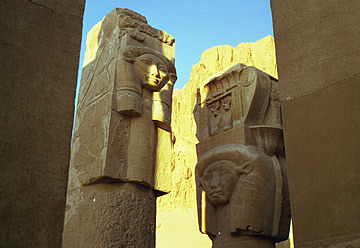
In the southern colonnade is a depiction of the expedition to Punt - the greatest achievement of the Queen's reign. The images include one of the local queen of marvelous girth, no doubt a sign of great wealth. Prized myrrh resin and some of the trees from which it is obtained, ebony, ivory, incense, gold, spices, baboons, and all manner of valuable and curious goods were brought back from Punt.
Through the Punt colonnade is the Chapel of Hathor - the face of the beautiful cow-eared goddess appears at the top of the pillars here.
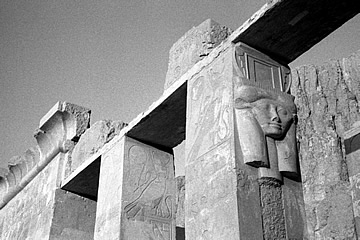
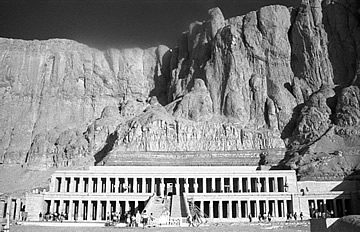
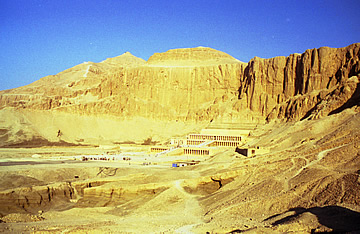
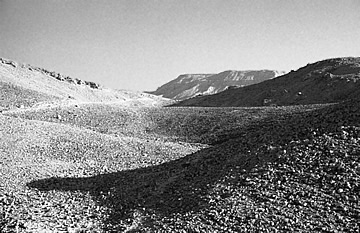
On our second visit to the Mortuary Temple of Queen Hatshepsut we arrived very early for a special reason: after our visit we were going to walk across the mountain pass between the temple and the Valley of the Kings.
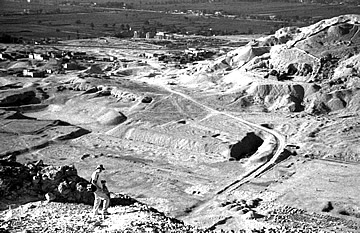
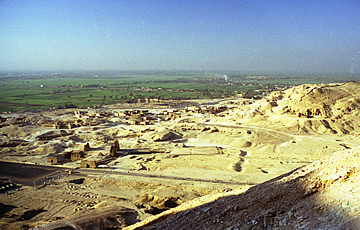

The views of the temple all the way up are marvellous and the mountainside is dotted with recesses where the pharaoh's guards watched over the site. As we climbed higher the misty Nile and its vivid green flood plain developed into a stunning panorama.
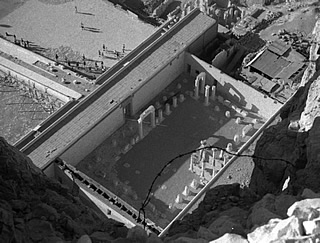
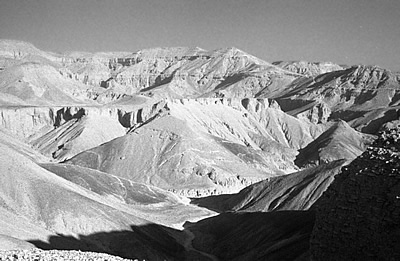
The ground is stony and can be quite difficult underfoot, and the track does diverge at certain points so it is possible to take a wrong turn and we were very glad we had a guide.
Easily one of the most memorable walks we have made, it began with a steep climb which came out above the temple so that, with care, we could look down into the ruins, and into the closed areas.
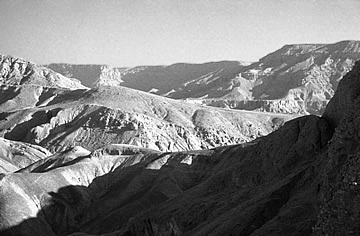
Our guide would not allow us to take this expedition on our own - in the years between our two visits there had been a terrible massacre of tourists at Deir el Bahri and the Egyptians were being very protective. In 2000 all the tourist sites were watched by armed guards.
At the very top of the pass was a military guard post.
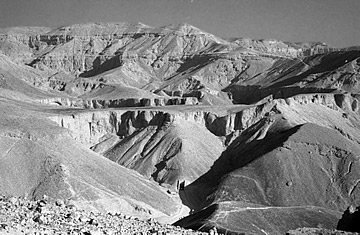
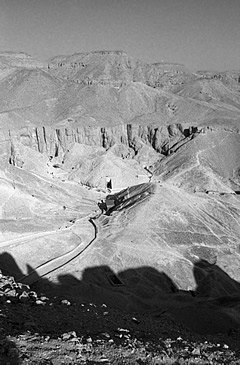
As we began our descent into the Valley of the Kings the tombs gradually came into sight. The walk took us about one hour and we arrived at around 8.30a.m. when it was already getting very hot. There were very few tourists about at this time, though we did pass one German who was "the first of his party to attempt this climb"!
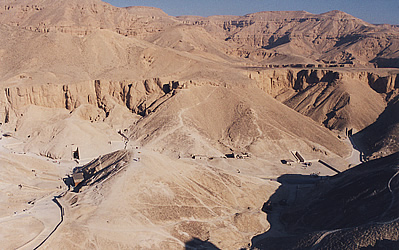
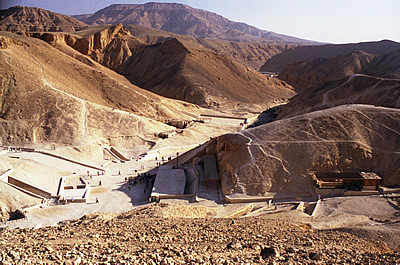
We visited many of the tombs in the Valley of the Kings, some more memorable than others.
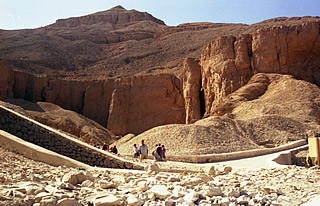
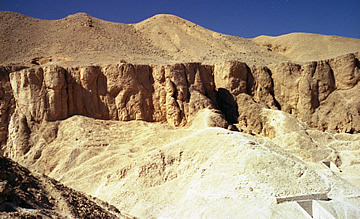
The tomb of Tutankhamun is probably one of the least impressive. In 1989 you couldn't really see very much, nor go "inside" the tomb at all - the impression was of a jumble of artefacts (the best are now in the Cairo museum).
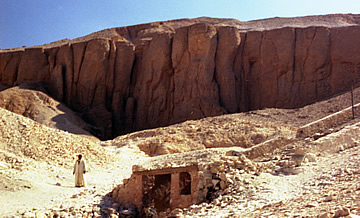
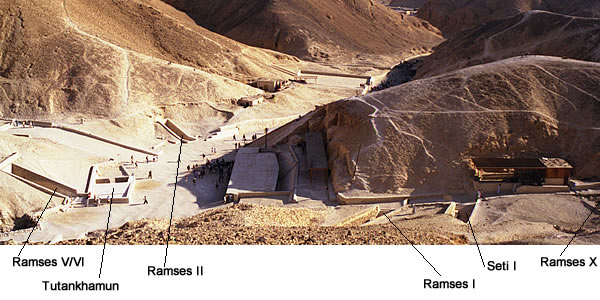
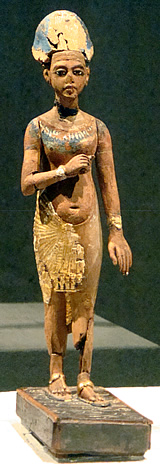
The three tombs highlighted here were all visited in 2000.
The tomb of Amenhotep II is reached by a long corridor and steep steps. The walls of one of the chambers bear the complete text of the Anduat - the Book of the Underworld. The blue ceiling is painted with yellow stars and the huge sarcophagus remains in position.
The tomb of Tuthmosis III has a cartouche-shaped sarcophagus chamber and a translucent sarcophagus with Nut carved inside.
Both these tombs had deep shafts crossed by footbridges to deter tomb robbers, and similar starred blue ceilings. Blue papyrus plants, symbol of the south, are painted on the walls.
The tomb of Sa-ptah has very fine paintings including one of the mummification process. Deep underground the unfinished sarcophagus chamber contains a huge sarcophagus bearing images of Isis and Nephtys.

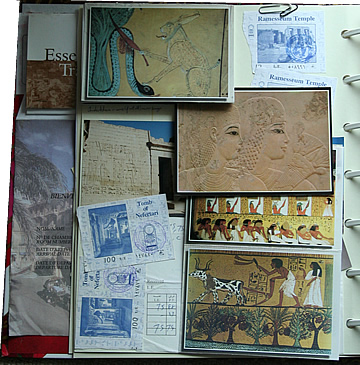
South of Deir el Bahri lie the Tombs of the Nobles. The decorations of these are fascinating because they are often of everyday life in contrast to the more death and afterlife preoccupation in the tombs of the Pharaohs. The local limestone is apparently not good for carving, hence the preponderance of painted decoration. No photography allowed inside the tombs.
The tomb of Ramose is particularly interesting because the decoration spans the reigns of Amenhotep III and Amenhotep IV. This is an important era of change in Egyptian society, when the worship of the sun disk - the Aten - was introduced by Amenhotep IV who changed his name to Akhenaten - "he who is pleasing to Aten".
Ramose was a very important man being Governor of Thebes and Vizier, and so he has a fine large tomb. In Akhenaten's reign the painting became more realistic. However, Akhenaten and his wife Nefertiti are both shown with elongated heads which may be an idiosyncratic style of the period rather than realism. There is a fine and distinctive image of the rays of Aten.
Also in this tomb can be seen a red grid on a wall giving a clue as to how the paintings were created: the artist copying from a gridded sketch to get the proportions correct.
In the tomb of Nakht, a scribe and astronomer of Amun, colourful scenes of agricultural activities accompany scenes of hunting and feasting. This is really nice - depictions of everyday life.
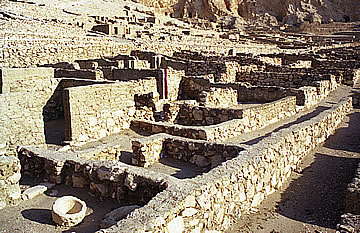
South of the Tombs of the Nobles lies the workmen's village of Dehr el Medina. Here lived the men who created the tombs of the pharaohs and consequently, in imitation, they decorated their own tombs with scenes of the afterlife which include domestic and agricultural scenes. Over the tomb they often raised a small pyramid.
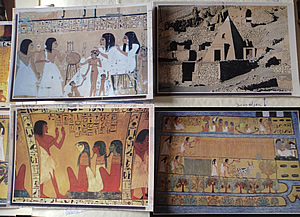
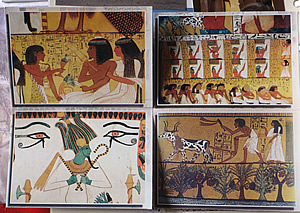
It is refreshing, after so many tombs and temples, to see some living space. Unfortunately most of it is off limits and no photography is allowed inside the tombs themselves.
The tombs of Sennedjem and Inherkau are particularly impressive.
Sennedjem's has some of the very best wall paintings. Sennedjem - "Servant in the Place of Truth" - lived during the reigns of Seti I and Ramses II.
When discovered in 1886 Sennedjem's tomb held 30 mummies. The tomb is covered in marvellous paintings including Sennerdjem and his wife ploughing and sowing fields in the afterlife.
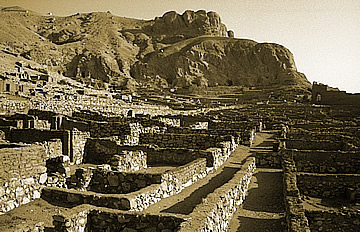
Inherkhau - "Foreman of the Lord of the Two Lands in the Place of Truth" - lived during the reigns of Ramses III and Ramses IV. Inherkau's tomb has some wonderful animal paintings including the famous "Cat slaying the Apophis Serpent", though the cat looks remarkably like a hare!
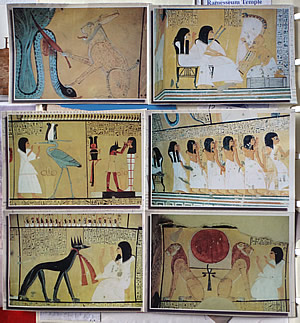
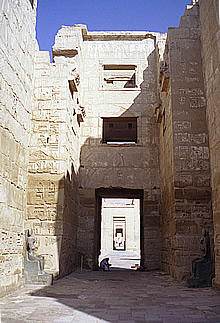
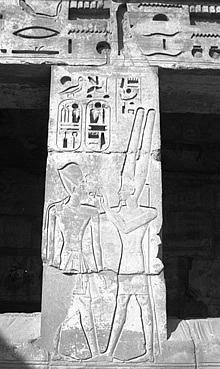
This is one of the most magnificently decorated temples in this part of Egypt and with quite a bit of colour remaining.
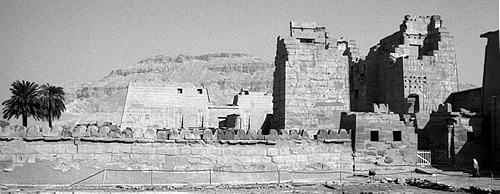
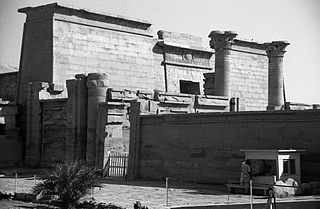
The complex is entered via a huge gateway, quite unique in ancient Egyptian architecture, meant to resemble a Syrian fortress encountered during battle. The left front wall shows the pharaoh with raised club holding enemy soldiers by the hair.
To the right of this gateway is a temple which was built by Hatshepsut - as elsewhere her name and image have been obliterated by Tuthmosis III. Akhenaten, the sun-worshipper, in turn tried to remove references to Amun, but these were later reinstated by Horemheb and Seti I. Ramses III then decorated the walls.2
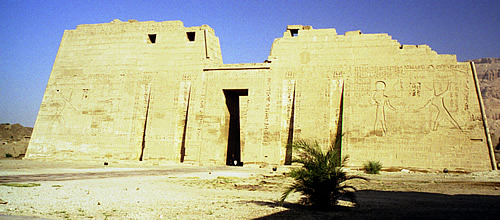
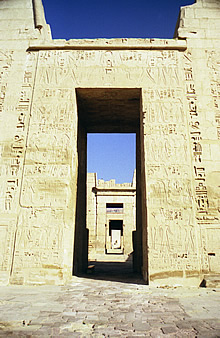
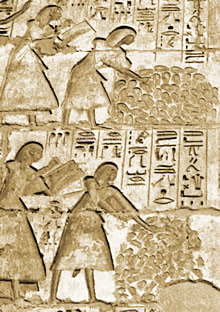
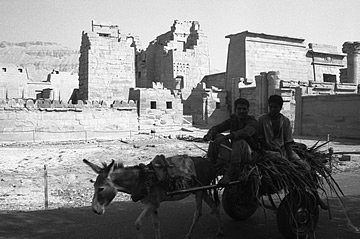
The temple has two courtyards, one after the other, through which is reached a hypostyle hall. The second and third pylons are approached by shallow staircases, the second court being higher than the first and the hypostyle hall slightly higher again - an architectural device to emphasise the importance of the final sanctuary.
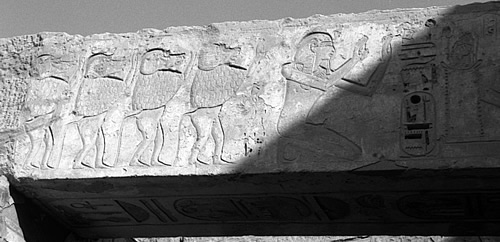
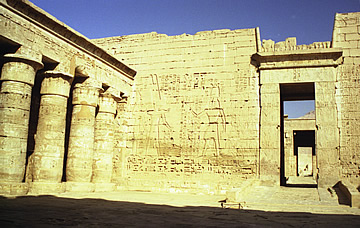
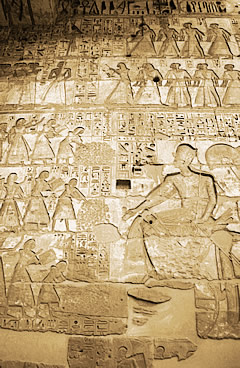
In the first courtyard the east wall celebrates Ramses' victory over the Libyans and shows piles of enemy hands and genitals.
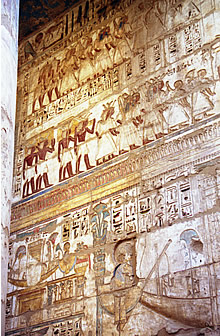
Collecting body parts is a long-established method of determining how many of the enemy had been killed - Tamerlane collected heads and piled them up in towers!
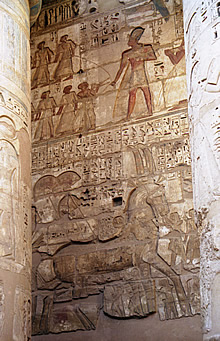
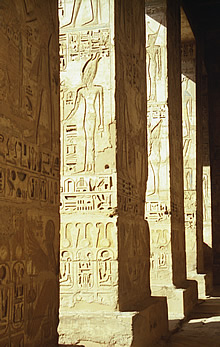
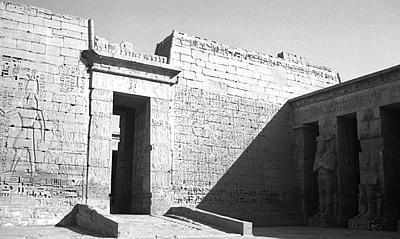
Within the well-preserved temple precincts the inscribed images, scripts and designs are particularly deeply cut - a device intended to thwart succeeding pharaohs who might attempt to erase them. The scenes of the battle with the Sea Peoples which Ramses fought in 1176 BC is the only known ancient Egyptian depiction of a sea battle.
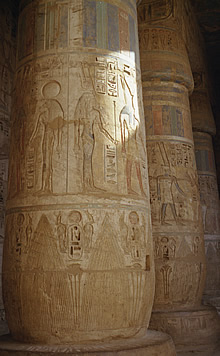
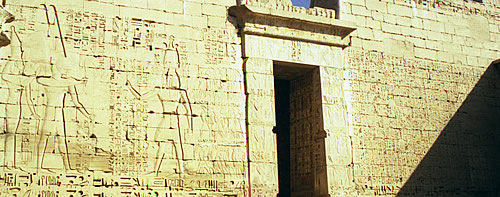
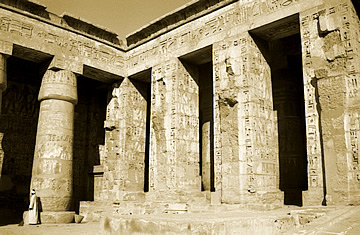
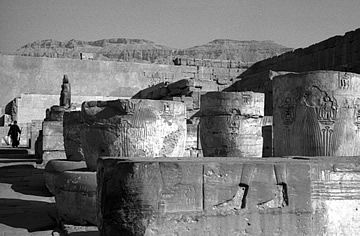
In the second courtyard the closed lotus bud columns are beautifully carved and still retain a lot of colour.
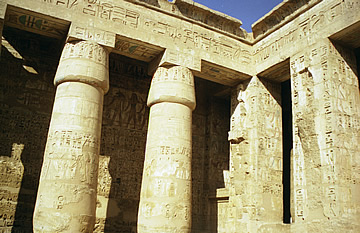
The third courtyard is the remnants of a hypostyle hall, only short sections of the many columns now remain.
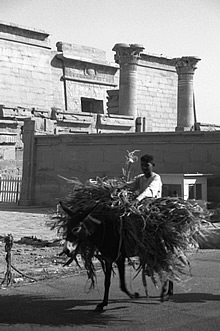
We were lucky to be here when there were no other visitors and this made the site even more atmospheric, though the vivid carvings and decorations make this temple worth visiting even if it is crowded.
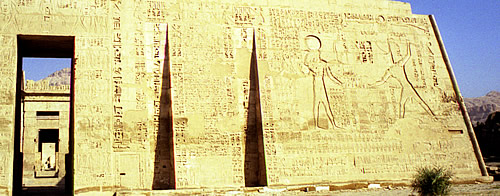
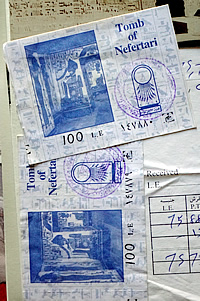
The tomb of Nefertari, beloved wife of Ramses II, is the most beautiful of all. Visitor numbers are restricted and, as usual in the tombs, photography is forbidden. The tomb was the subject of a major restoration project completed in 1992.
The striking colours of the paintings are unlike anything else we had seen anywhere in Egypt.
There are many images of this beautiful queen, including one of her playing a board game called "senet", and of the gods and goddesses and scenes from the Book of the Dead. Also one of her with a wrinkled neck - most unusual to see what we would consider a sign of age - but perhaps it meant something good in the Egyptian culture. The pillars are magnificently coloured - horizontal stripes of black, orange yellow and green in a tree trunk shape flanked by cartouches on a white background. All the walls are covered with images of Nefertari, hieroglyphs, images from the Book of the Dead - a wonderfully colourful array, most on a white background. It is truly magnificent.
As of January 1st, 2003 the tomb has been closed to visitors in order to assess whether too much damage is being done to the paintings.